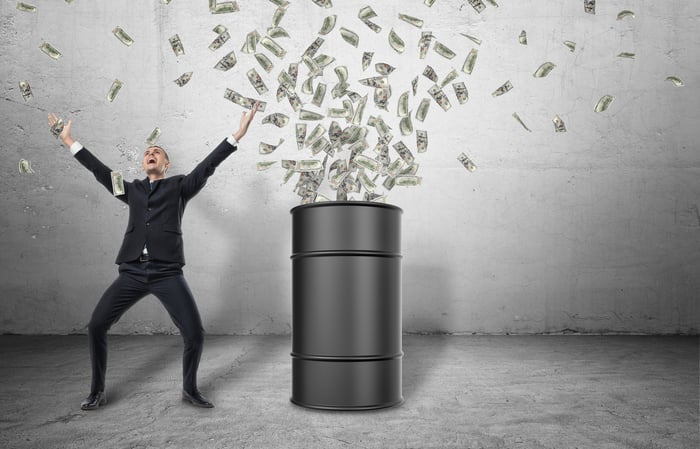After spending the past few years battling oil lower prices, optimism has flooded back into the oil market. That's after crude prices have come roaring back from their lows and have risen above even the most optimistic forecast. With oil recently in the mid-$60s, companies that were gearing up for $50 oil should reap a windfall of cash flow this year.
That has them poised to go on a spending spree. However, instead of ramping up their capital investments or making acquisitions, many plan to use that cash to buy back their stock. Several have already unveiled needle-moving share repurchase plans, which should drive others to follow since these trailblazing programs have had a noticeable impact on share prices.

Energy CEOs are celebrating higher oil prices. Image source: Getty Images.
At first, a trickle
U.S. oil giant ConocoPhillips was one of the first energy companies to unveil plans to start buying back its stock as it began emerging out of the market downturn. It made that announcement in November 2016, saying at the time that it planned to sell up to $8 billion in assets over the next few years and would use $3 billion of the proceeds to repurchase its shares. However, after unloading $16 billion in assets last year, the company supercharged that plan by saying it would buy back $3 billion in stock during 2017 and another $3 billion in the following two years. It would go on to expand that to $7.5 billion through 2020, and recently announced plans to accelerate the buyback in 2018 by repurchasing $2 billion this year instead of $1.5 billion. The company made good on its promises so far, spending $3 billion last year, which reduced its share count by 5%.
More large oil companies followed that lead last year. Canadian oil sands giant Suncor Energy declared a buyback worth 2 billion Canadian dollars ($1.6 billion) in April. Suncor got right to work on repurchasing shares, having spent CA$578 million ($471 million) through the third quarter. Meanwhile, in September, Anadarko Petroleum announced a $2.5 billion stock repurchase program, which had the potential to reduce its outstanding shares by 10%. Anadarko also noted that it planned to immediately act on the authorization, as it expected to buy back $1 billion in stock by year-end and the rest in 2018.
These repurchases have paid immediate dividends for investors, with all three of these oil stocks outperforming rivals since announcing their plans.
|
Oil Stock |
Return Since Announcing Buyback |
Peer Group Return Over That Time Frame |
|---|---|---|
|
Anadarko Petroleum (APC) |
36.50% |
11.40% |
|
ConocoPhillips (COP -0.59%) |
32.70% |
5.70% |
|
Suncor Energy (SU 0.13%) |
17.60% |
9% |
Data source: YCharts. Peer group return as measured by the Vanguard Energy ETF.
That outperformance is why it's no surprise to see other oil and gas producers unveil buyback programs in recent months. Oil giant Hess (HES 0.35%) affirmed in mid-November that it planned to buy back $500 million of its stock in 2018. In the meantime, Gulfport Energy (GPOR) revealed a $100 million buyback plan last month. While that might not sound like a lot, it's enough to retire 5% of Gulfport's outstanding stock at the current price.

More oil companies could be sending cash back to investors this year. Image source: Getty Images.
A gusher of repurchases on the way?
Other producers are evaluating their options given the increasing likelihood that they'll generate more cash than needed to fund their 2018 plans. Natural gas producer Antero Resources (AR 0.16%), for example, recently said that it plans to "evaluate various potential measures to address the discount in trading value of Antero's stock relative to some" of its peers. Among the things it's considering is a return of capital to investors, which could include buying back some of its relatively cheaper shares.
Several oil companies have hinted that they, too, could return more cash to investors in the coming year, depending on cash flow. Devon Energy (DVN -0.54%) noted that one of the aspects of its Devon 2020 plan would be to return cash to investors. While this could mean increasing the dividend, given the success rivals have had with their buybacks, Devon might choose to follow that blueprint for improving shareholder value. Occidental Petroleum (OXY -0.27%), likewise, said that share repurchases are one of the priorities for its cash flow, with future buybacks subject to market conditions. As more producers move forward with plans to repurchase shares, it could force others to follow their lead so that they don't seem stingy with shareholder capital.
This year could be what energy investors have been waiting for
The past few years have been rough for those who own oil stocks. However, that could change in 2018 since producers are generating much more cash than they currently need thanks to soaring crude prices. While some have already started sending money back to investors, more will likely unveil similar plans this year, especially if crude remains in the mid-$60s. Those buybacks could ignite their stocks in much the same way it has for those who've already started scooping up shares.





